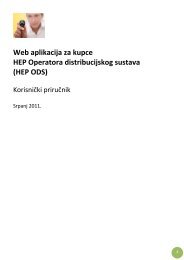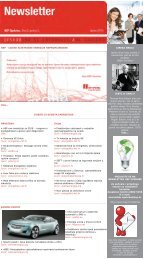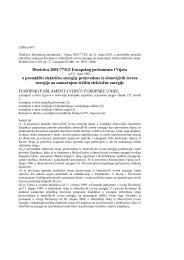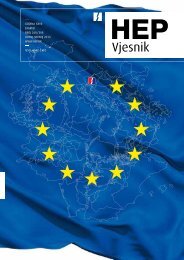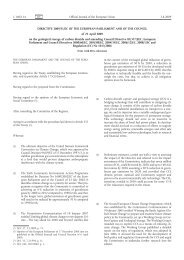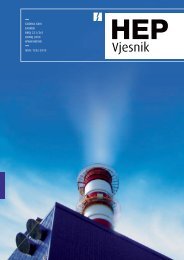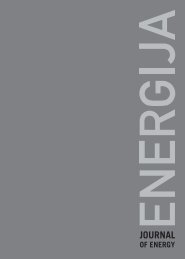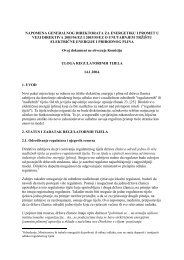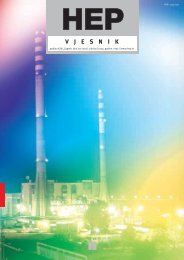You also want an ePaper? Increase the reach of your titles
YUMPU automatically turns print PDFs into web optimized ePapers that Google loves.
Glavni razlog potrebe usvajanja obnovljivih<br />
izvora energije u proizvodnji elektriËne energije<br />
jest njihov doprinos zaustavljanju ili smanjenju<br />
proizvodnje CO 2<br />
.<br />
Meappleutim, slika 4 prikazuje troπak izbjegavanja,<br />
odnosno uπtede proizvodnje 1 tone CO 2<br />
proizvodnjom<br />
energije dobivene iz vjetra na moru i na<br />
kopnu. Troπak energije dobivene iz vjetra i na moru<br />
i na kopnu znatno je viπi od troπka koriπtenja nekih<br />
termiËkih tehnologija, od kojih je najznaËajnija<br />
nuklearna. U nuklearnoj proizvodnji troπak<br />
izbjegavanja proizvodnje 1 tone CO 2<br />
moæda iznosi<br />
svega 20 % troπka vjetroelektrana na moru i 40 %<br />
troπkova vjetroelektrana na kopnu. Valja istaÊi da<br />
bi sve ostale naznaËene termiËke tehnologije<br />
proizvodnje trebale ukljuËivati spremiπta za<br />
skladiπtenje ugljikovog dioksida, tehnologije koja<br />
se joπ nije potpuno dokazala.<br />
The main reason advanced for the adoption of renewables<br />
in electricity generation is their contribution<br />
to the arresting or reducing of the production<br />
of CO 2<br />
.<br />
Figure 4 shows, however, the cost of avoiding<br />
or saving the generation of 1 tonne of CO 2<br />
from<br />
both onshore wind generation and offshore wind<br />
generation. Both are significantly higher than by<br />
using some thermal generation technologies the<br />
most notable of which is nuclear. With nuclear<br />
generation the cost of avoiding the production of<br />
1 tonne of CO 2<br />
is perhaps 20 % of that on offshore<br />
wind or 40 % of onshore wind. It should be noted<br />
that all the other thermal generation technologies<br />
indicated would need to include carbon capture<br />
storage, a technique not yet fully proven.<br />
Slika 4<br />
Troπak izbjegavanja<br />
emisija ugljikovog<br />
dioksida<br />
Figure 4<br />
Cost of avoiding<br />
carbon emissions<br />
NE / NPP<br />
SC-CCS<br />
IGCC-CCS<br />
CCGT-CCS<br />
Vjetroelektrane<br />
na kopnu /<br />
Onshore wind<br />
Vjetroelektrane<br />
na moru /<br />
Offshore wind<br />
NE / NPP ∑ Nuklearne elektrane /<br />
Nuclear power plants<br />
SC-CCS ∑ SuperkritiËna para /<br />
Super critical steam, skladiπtenje<br />
CO 2<br />
/ carbon capture storage<br />
IGCC-CCS ∑ Konverzija ugljena<br />
u sintetiËki plin / Integrated<br />
gasification combined cycle,<br />
skladiπtenje CO 2<br />
/ carbon capture<br />
storage<br />
CCGT-CCS ∑ Kombinirani plinskoparni<br />
ciklus / Combined cycle gas<br />
turbine, skladiπtenje CO 2<br />
/ carbon<br />
capture storage<br />
0 20 40 60 80 100 120<br />
(EUR/t) uπteappleenog / saved CO 2<br />
6.4 Izgradnja novih kapaciteta za proizvodnju<br />
elektriËne energije i meappleusobno spajanje<br />
Zadnjih 25 godina u Europi je izgraappleeno veoma malo<br />
elektrana i svega nekoliko 400 kV vodova. Sigurnost<br />
opskrbe elektriËnom energijom odræavana je u tom<br />
razdoblju kroz poboljπanje energetske uËinkovitosti<br />
u potroπnji i smanjenjem kapaciteta tradicionalnih<br />
energetski intenzivnih industrija diljem Europe.<br />
Poboljπanje energetske uËinkovitosti, πto je bitno<br />
obiljeæje europske energetske politike, moæe<br />
pripomoÊi smanjenju rasta potraænje za elektriËnom<br />
energijom, no malo je procjena koje ukazuju na bilo<br />
kakvo smanjenje potraænje. Izgraappleeni su znaËajni<br />
kapaciteti obnovljive i distribuirane termiËke proizvodnje<br />
energije. Postignuta su, doduπe skromna,<br />
smanjenja u maræama elektrana, koje bi u<br />
buduÊnosti mogle ugroziti izvore opskrbe.<br />
6.4 Building new generation and interconnection<br />
capacity<br />
Very little central generating plant and few 400 kV<br />
circuits have been built in Europe over the past<br />
25 years. Secure supplies of electricity have been<br />
maintained over this period by improved user energy<br />
efficiency and a reduction in the capacity of<br />
traditional energy consuming industries throughout<br />
Europe. Energy efficiency improvements, a central<br />
feature of European energy policy, may help to reduce<br />
the rate of growth of demand for electricity,<br />
but few estimates show any reduction in demand.<br />
Significant amounts of renewable and distributed<br />
thermal generation have been installed. There have<br />
been some modest reductions in system plant<br />
margins which could threaten sources of supply<br />
in future.<br />
Kennedy, M. W., StaniÊ, Z., Energetska politika u Europi i..., Energija, god. 56(2007), br. 3., str. 268∑291<br />
Kennedy, M. W., StaniÊ, Z., Energy Policy in Europe and..., Energija, vol. 56(2007), No. 3, pp. 268∑291<br />
282



